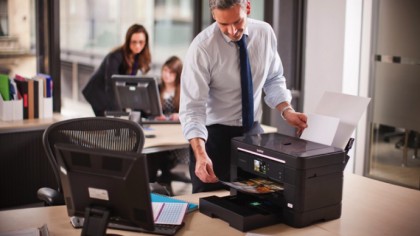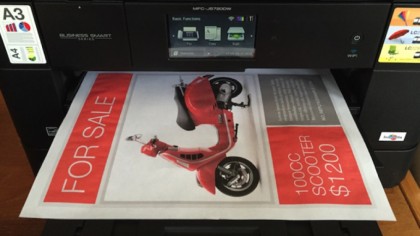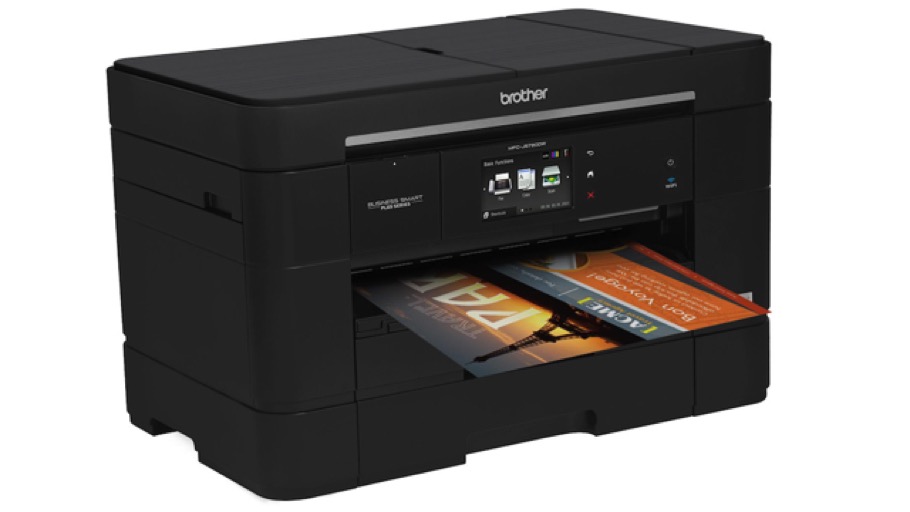TechRadar Verdict
An excellent all-rounder with surprisingly low running costs
Pros
- +
Excellent connectivity including cloud support
- +
Very low running costs by inkjet standards
- +
Does almost anything
Cons
- -
Can be slow in full colour mode
- -
Only includes starter cartridges
- -
Weighs a ton
Why you can trust TechRadar
The MFC-J5720DW is the king of Brother's newly refreshed small office/home office range, with a list of features that could fill its 580-sheet paper capacity. It offers duplex printing, A3, scanning, copying and faxing, wired, wireless and USB connectivity and uses high capacity cartridges that promise to cut the often ruinous cost of inkjet printing. Does it live up to its billing?
Setup and specifications
Despite the lengthily list of features - and an equally hefty weight of 14.5 kg, so watch your back when you lift it - the MFC-J5720DW is simple to set up using Wi-Fi Direct for easy wireless configuration as well as the familiar USB and Ethernet options. Wireless security comes in 64/128-bit WEP, WPA-PSK and WPA2-PSK flavours and the wireless radio works with 802.11b/g/n, but not the newer 802.11ac.

There are four ways to get paper into the MFC-J5720DW. There's a 250-sheet paper tray with a second tray with the sam capacity beneath it, a rear tray for loading up to 80 sheets of A4 or 5 sheets of A3, a single-sheet manual feed and a 50-sheet automatic double-sided document feeder. The output tray holds 50 sheets.
The scanner supports both flatbed scanning and scanning via the automated document feeder, and in the latter case it can scan double-sided documents. Flatbed scanning can be done at up to 2,400 x 2,400 dpi and ADF scanning at up to 2,400 x 1,200 dpi, and there's an interpolation mode that effectively delivers up to 19,200 x 19,200 dpi. The scanner doesn't need a PC or Mac to function thus allowing you to scan to email, files, flash drives and FTP. You can also scan on Windows networks, email servers and web servers too. Scanning takes 3.37 seconds for A4 at 100dpi.
Installing and configuring the printer is simple enough, if a little time consuming with a four-minute wait once you've installed the ink cartridges as the printer cleans itself. It's worth noting that the supplied cartridges are starter ones, not high capacity ones, so you should factor in the cost of a full set of cartridges when you consider the purchase price.
Performance and running costs

Print quality is up to 6,000 x 1,200 dpi and in fast mode Brother states speeds of up to 35ppm in mono and 27ppm in colour. If you prefer ISO images per minute, Brother claims laser comparable quality at 22ipm in mono and 20ipm in colour, and copying at 12ipm and 9ipm for mono and colour respectively.
Fast mode is certainly fast, but quality suffers as text is legible rather than pin-sharp and colours appear somewhat washed out. It's fine for everyday office use and we found that the printer delivered real-world speeds close to the manufacturer's figures for standard word processing documents in mono and with spot colours.
As you'd expect, printing in full colour and/or on A3 takes longer - and it also makes quite a bit of noise, with the printer emitting the high-pitched whistling sound of a slowly deflating balloon while it prints. A single full-colour A3 image using default settings took around 20 seconds to begin printing over our 802.11n wireless network and six minutes to complete whilst a simpler A4 document with heavy use of block colours took two minutes. The results were excellent. Even on cheap copy paper, colours were bright and solid with even difficult areas such as dark blues on blacks rendered faithfully. As with all colour printing, paper quality is paramount and on cheaper paper the ink can oversaturate the paper, causing it to wrinkle and reduce the sharpness.
One of the most important figures with any printer is its running costs, which Brother hopes to keep low by offering high yield cartridges delivering up to 2,400 A4 pages in black and 1,200 pages for each colour. We found the official cartridges retailing at £20.92 ex VAT for black and £11.93 for colour, which works out at 0.9p per page in black and 3.9p per page in CMYK, excluding paper costs. As ever, those costs are based on manufacturers' figures for 5% coverage on A4. By way of comparison, budget SOHO mono laser printers cost around 2p per page to run.
Writer, broadcaster, musician and kitchen gadget obsessive Carrie Marshall has been writing about tech since 1998, contributing sage advice and odd opinions to all kinds of magazines and websites as well as writing more than a dozen books. Her memoir, Carrie Kills A Man, is on sale now and her next book, about pop music, is out in 2025. She is the singer in Glaswegian rock band Unquiet Mind.

